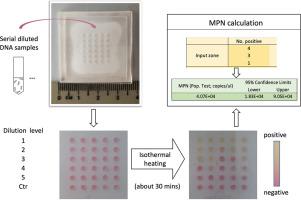Water Research ( IF 11.4 ) Pub Date : 2021-04-26 , DOI: 10.1016/j.watres.2021.117172 Jing Fu , Elaine Li Ching Chiang , Carl Angelo Dulatre Medriano , Liyan Li , Sungwoo Bae

|
Fecal contamination of water and its associated pathogens are a major public health concern in both developing and industrialized areas. Fecal indicator bacteria (FIB) are commonly used to assess microbial water quality, but they require a relatively long period of incubation time. Currently, molecular techniques have been applied to rapidly detect FIB. However, these molecular techniques require expensive and sophisticated equipment. In this study, we developed a rapid on-chip gene quantification method based on loop-mediated isothermal amplification (LAMP) PCR. The LAMP assays can measure the target genes of the fecal indicator bacteria (FIB), including E. coli and Enterococcus spp, using the most probable number (MPN) approach. The colorimetric LAMP assay allows for naked-eye observation of the PCR reaction as few as 4 gene copies / well. When the reaction ends, MPN measurement of positive outcomes on the white-based PMMA (polymethacrylic acid) microchips provides the concentrations of the target genes of FIB with a confidence interval. We validated the feasibility of the MPN-LAMP approach by obtaining a strong correlation between the results of the MPN estimations and the qPCR analysis. Moreover, the MPN-LAMP approach was used to quantify the FIB in different environmental water collected from the freshwater reservoirs, beach, agriculture farm, and sewage. Our research demonstrates that the MPN- LAMP method enables us to easily and quickly quantifying FIB genes isolated from the environment without expensive qPCR instruments.
中文翻译:

在聚甲基丙烯酸甲酯(PMMA)微芯片上使用最可能的数环介导的等温扩增(MPN-LAMP)方法对水中的粪便指示菌进行快速定量
在发展中和工业化地区,粪便中水及其相关病原体的污染都是主要的公共卫生问题。粪便指示菌(FIB)通常用于评估微生物的水质,但是它们需要较长的孵育时间。当前,分子技术已被用于快速检测FIB。但是,这些分子技术需要昂贵且复杂的设备。在这项研究中,我们开发了一种基于环介导的等温扩增(LAMP)PCR的快速芯片上基因定量方法。LAMP分析可以测量粪便指示菌(FIB)的靶基因,包括大肠杆菌和肠球菌,使用最可能数(MPN)方法。比色LAMP测定法允许肉眼观察PCR反应至少至4个基因拷贝/孔。当反应结束时,基于白色的PMMA(聚甲基丙烯酸)微芯片上阳性结果的MPN测量提供了置信区间的FIB靶基因浓度。我们通过获得MPN估计结果与qPCR分析之间的强相关性,验证了MPN-LAMP方法的可行性。此外,MPN-LAMP方法用于量化从淡水水库,海滩,农业农场和污水中收集的不同环境水中的FIB。









































 京公网安备 11010802027423号
京公网安备 11010802027423号